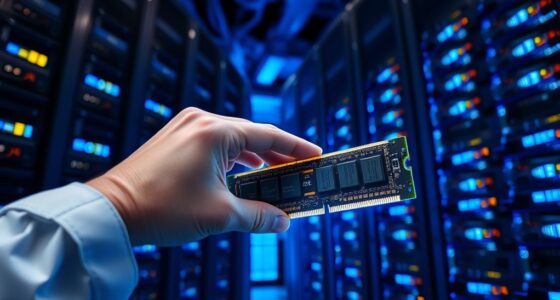Enabling SSD storage greatly boosts I/O performance compared to traditional HDDs, as SSDs access data faster with no moving parts. NVMe drives, connected via PCIe, offer even quicker speeds—up to 7,000 MB/s—making them ideal for demanding tasks. SATA SSDs are a good middle ground, providing faster speeds than HDDs at a lower cost. Understanding these differences helps you choose the best option to maximize speed and reliability, along with tips to optimize your setup.
Key Takeaways
- NVMe SSDs offer the highest I/O speeds, significantly reducing latency and increasing data transfer rates compared to HDDs and SATA SSDs.
- HDDs have mechanical limitations causing slower access times, making them less suitable for high-performance I/O tasks.
- SATA SSDs provide faster I/O performance than HDDs but are limited compared to NVMe drives due to interface constraints.
- NVMe drives utilize PCIe lanes with high queue depths, enabling parallel processing for superior I/O throughput.
- Upgrading to SSD or NVMe storage enhances system responsiveness, especially for data-intensive applications like gaming, editing, and servers.
Understanding Storage Technologies: HDD, SSD, and NVMe

Understanding the differences between HDDs, SSDs, and NVMe drives is essential when selecting storage for your needs. HDDs store data on spinning magnetic disks with moving read/write heads, making them slower and more prone to mechanical failure. SSDs use NAND flash memory chips, which have no moving parts, offering better durability and faster access times. NVMe drives also rely on NAND flash but connect via the PCIe interface and use the NVMe protocol, allowing for more efficient data transfer and higher scalability. While HDDs are cost-effective for large storage, SSDs provide a good balance of speed and affordability for everyday use. NVMe drives excel in high-performance environments, delivering faster throughput and lower latency by leveraging advanced protocols and direct CPU communication. Additionally, storage interfaces play a crucial role in determining data transfer speeds and compatibility with various systems.
Performance Metrics and Speed Benchmarks

Performance metrics and speed benchmarks reveal how different storage technologies compare in real-world use. PCIe Gen 4 NVMe SSDs reach up to 7,000 MB/s in sequential reads, with writes above 4,000 MB/s. PCIe Gen 3 models typically top out around 3,500 MB/s, while SATA SSDs max out near 550 MB/s due to interface limits. HDDs offer only 100–230 MB/s. NVMe SSDs deliver 10-25 times faster sequential speeds than enterprise HDDs and 2-5 times faster than SATA SSDs. In IOPS, NVMe drives support hundreds of thousands to over a million, far exceeding HDDs’ low thousands. Latency is also much lower—below 100 microseconds—compared to HDDs’ milliseconds. These benchmarks highlight NVMe’s superior speed, making it ideal for demanding applications. Additionally, advanced storage protocols enhance overall performance and reliability in NVMe drives.
Latency and I/O Operations Explained
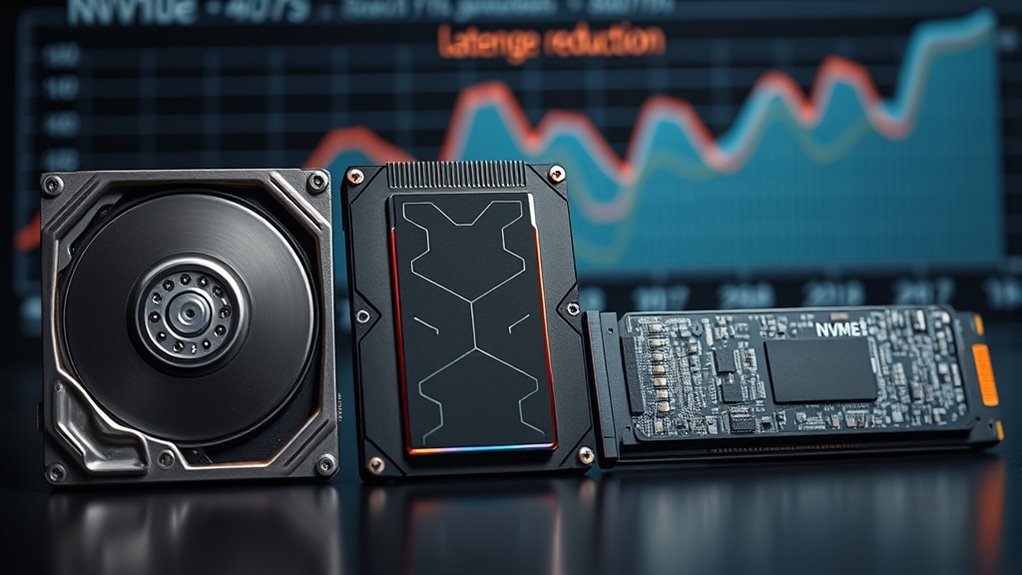
Understanding latency and I/O operations helps you see why different storage devices perform differently under load. Access times vary greatly, with HDDs taking milliseconds and NVMe SSDs measuring in microseconds, impacting response speed. Command queue management also plays a key role, with NVMe supporting thousands of queues to handle multiple operations simultaneously, reducing delays.
Access Time Differences
While all storage devices aim to retrieve data quickly, their access times vary considerably due to differences in technology. HDDs rely on mechanical parts like spinning disks and read/write heads, resulting in slower access times. In contrast, SSDs use flash memory, which provides faster data retrieval. NVMe SSDs, connected via PCIe lanes, have even lower latency thanks to direct access to the CPU. This means NVMe drives can fetch data quicker than SATA SSDs and HDDs, improving overall system responsiveness. Faster access times are especially noticeable during tasks like gaming, large file transfers, or database operations. NVMe’s design exploits parallel processing and low latency, making it the best choice for applications demanding rapid data access and minimal delay. Additionally, the ability to facilitate remote collaboration through faster data transfer speeds can enhance productivity in distributed work environments.
Command Queue Management
Command queue management is essential for optimizing how storage devices handle multiple I/O requests simultaneously. It allows you to send several commands without waiting for each to finish, boosting throughput and reducing idle time. NVMe supports up to 65,535 queues with 65,535 commands each, enabling massive parallelism aligned with SSD internal architecture. This reduces contention and latency, unlike SATA/SAS, which have single queues and higher protocol overhead. Native Command Queuing (NCQ) in SATA improves HDD performance by reordering commands, but offers limited benefits for SSDs. NVMe’s architecture uses paired submission and completion queues, allowing each CPU core to manage dedicated queues, minimizing delays. Higher queue depths mean more commands in flight, increasing performance under heavy loads, but exceeding limits can cause I/O failures and latency spikes. Additionally, understanding Bedroom design principles can help optimize your workspace environment for better comfort and efficiency.
Cost-Effectiveness and Storage Capacity Considerations
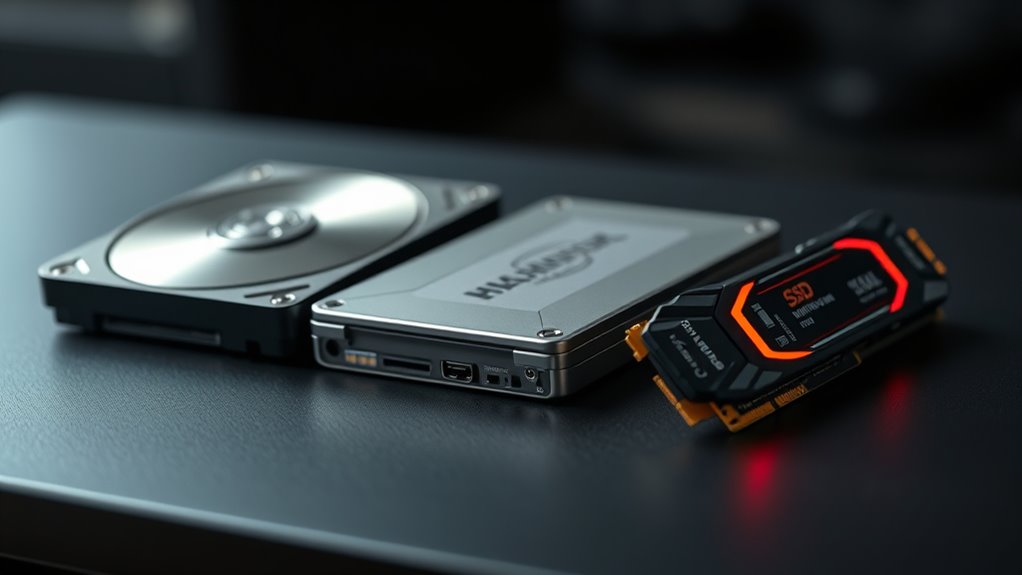
When comparing storage options, cost per gigabyte and maximum capacity are key factors to contemplate. HDDs offer the lowest cost per GB, making them ideal for large-scale storage like backups or archives, with capacities reaching up to 36TB. SATA SSDs strike a balance, providing faster speeds at a moderate price, typically up to 4TB, with some enterprise models reaching 16TB. NVMe SSDs deliver high performance but come with a higher cost per GB, especially at capacities above 2TB—most consumer models range from 1–4TB. Although NVMe prices are decreasing, they remain pricier than HDDs and SATA SSDs. For bulk storage, HDDs are the most cost-effective, while SSDs suit active use where speed outweighs capacity concerns. Additionally, the development of high-performance storage options such as NVMe SSDs continues to evolve, offering faster data transfer rates suitable for demanding applications.
Reliability, Durability, and Lifecycle Insights

You’ll notice that mechanical parts in HDDs make them more vulnerable to shock and wear, shortening their lifespan. SSDs, especially NVMe models, avoid these issues thanks to no moving parts and better durability. As you consider reliability, keep in mind how wear and mechanical risks impact each type’s longevity. Additionally, body awareness practices from somatic therapy can help users develop greater sensitivity to physical signs of hardware fatigue or stress, potentially extending device lifespan. Recognizing early signs of hardware stress through hardware monitoring tools can further aid in preventative maintenance and prolong the lifespan of your storage devices. Incorporating performance optimization strategies can also help maintain the health and efficiency of SSDs over time.
Mechanical Vulnerability Risks
Mechanical vulnerability considerably impacts the reliability and lifespan of storage devices. If you handle HDDs improperly, you’re risking damage from shocks, vibrations, or drops, which can cause data loss or complete failure. Unlike HDDs, SSDs and NVMe drives have no moving parts, making them much more resistant to physical impacts and environmental stresses. Here are three key points to contemplate:
- HDDs feature spinning platters and read/write heads, making them prone to head crashes, spindle failures, and platter damage.
- SSDs and NVMe drives, with their solid-state design, resist shocks, temperature extremes, and magnetic fields better than HDDs.
- Mechanical failures in HDDs are often sudden, while SSD electronics tend to fail more abruptly but with less mechanical risk.
Choosing the right storage means understanding these mechanical vulnerabilities.
Wear and Lifespan
Understanding the wear mechanisms and durability differences among storage devices is essential for making an informed choice. HDDs face mechanical wear from moving parts like spinning platters and read/write heads, typically lasting 3 to 5 years. SSDs, including SATA and NVMe, lack moving parts, so they avoid mechanical failure but wear out from repeated program/erase cycles on NAND flash memory. Higher-quality NAND and advanced wear-leveling extend their lifespan—SATA SSDs last about 5 to 6 years, while NVMe SSDs can reach 7 to 10+ years, especially enterprise-grade models. Reliability improves because SSDs don’t suffer from head crashes or platter damage. However, NAND degradation and data retention issues require firmware management. Additionally, ongoing AI safety measures help improve the reliability of storage devices by enabling better error detection and correction techniques. The wear mechanisms of SSDs are complex but manageable with proper maintenance and technology advancements. Furthermore, the manufacturing quality and manufacturing processes greatly influence the overall durability and lifespan of each device. Regular firmware updates and monitoring can further mitigate wear-related failures, enhancing device longevity. Overall, SSDs generally offer longer, more stable lifespans than HDDs, especially under moderate workloads and suitable conditions.
Practical Use Cases and Application Suitability

Choosing the right storage solution depends heavily on your specific use case and performance requirements. Here are three key scenarios where different drives excel:
- For business and office tasks, SATA SSDs (500GB–1TB) offer a solid balance of speed and cost, improving productivity for document editing, email, and web browsing. Additionally, low latency of SSDs results in a more responsive computing experience compared to traditional HDDs.
- In server environments, NVMe SSDs in RAID deliver high IOPS and low latency, perfect for databases and virtualization, while HDDs provide cost-effective bulk storage.
- Content creators benefit from NVMe’s high speeds for large file transfers, video editing, and rendering, whereas HDDs are suitable for archiving raw media assets.
- Emergency preparedness knowledge can help optimize your data storage strategies to ensure critical information remains accessible during crises.
Understanding these distinctions helps you optimize performance without overspending on unnecessary high-end solutions.
Compatibility, Form Factors, and Interface Differences
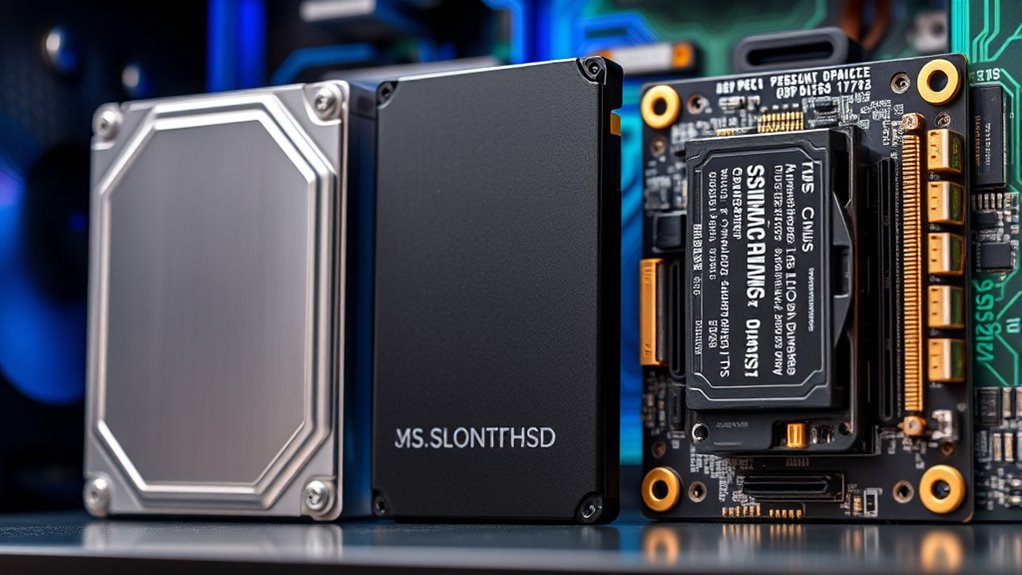
When selecting a storage device, it’s important to contemplate how its physical size and connection options fit with your system. HDDs usually come in 3.5-inch or 2.5-inch sizes, making them large and heavy, unsuitable for slim devices. SATA SSDs also use 2.5-inch or mSATA forms, which may be limited by older hardware. M.2 SSDs are compact, thin sticks that support SATA or NVMe protocols, fitting ultrabooks and small builds. NVMe SSDs typically use M.2 or U.2/U.3 forms, connecting via PCIe lanes for faster speeds. Compatibility depends on your motherboard’s slot support, keying (M-key or B+M-key), and BIOS updates. While SATA interfaces cap at around 600 MB/s, NVMe over PCIe can reach speeds exceeding 7,000 MB/s, offering vastly improved performance. Additionally, advancements in storage technology continue to push the boundaries of data transfer speeds and reliability.
Choosing the Right Storage Solution for Your Needs
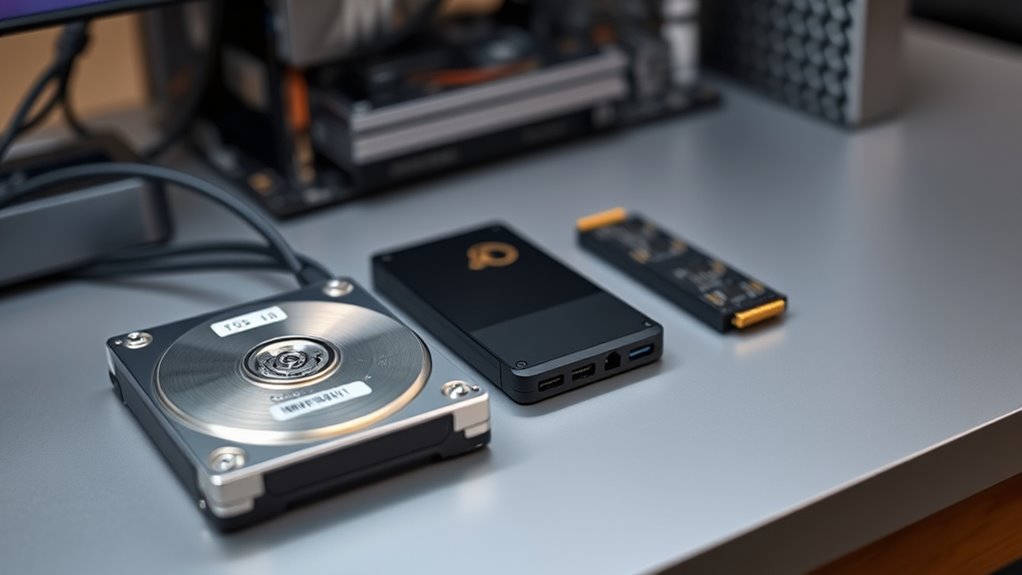
Selecting the right storage solution depends on your specific needs and priorities. To help you decide, consider:
- Performance Needs: If speed is critical—for gaming, video editing, or high-performance computing—NVMe SSDs deliver unmatched speed, up to 14,000 MB/s, and handle intense I/O tasks effortlessly. For instance, NVMe SSDs are especially beneficial for high-performance computing where rapid data access is crucial. Additionally, understanding your storage workload can help determine whether the speed benefits of NVMe are necessary for your tasks.
- Budget and Capacity: For large storage at a lower cost, HDDs are ideal, offering bigger capacities and affordability, but at slower speeds.
- Reliability and Power: SSDs and NVMe SSDs have no moving parts, reducing failure risk and offering better durability, plus they consume less power for eco-friendly, energy-efficient operation.
- Compatibility and Advanced Features: Ensuring your system supports NVMe interfaces and taking advantage of the latest technology can significantly enhance overall performance and future-proof your setup.
Match these factors with your workload, budget, and environment to choose the most suitable storage solution.
Frequently Asked Questions
How Do NVME Drives Impact System Boot Times Compared to HDDS?
NVMe drives considerably reduce your system’s boot times compared to HDDs. They use PCIe lanes, offering read/write speeds over 3,000 MB/s, which eliminates mechanical delays and speeds up OS loading. As a result, your Windows startup can take just 10–15 seconds with NVMe, versus over a minute with HDDs. This upgrade makes your system more responsive and reliable, especially during startup and multitasking.
Can SSDS or NVME Drives Improve Gaming Performance Noticeably?
Yes, SSDs and NVMe drives can noticeably improve your gaming performance. They reduce load times substantially, allowing games to start faster and assets to load seamlessly during gameplay. NVMe drives, being even faster, stream textures and assets more efficiently, especially in large open-world games. This results in smoother experiences with less stuttering and shorter waiting periods, making your gaming sessions more responsive and enjoyable.
What Are the Key Factors Affecting SSD Lifespan Besides TBW?
Sure, your SSD’s lifespan isn’t just about TBW—surprise! Factors like workload type matter. If you have random, small writes, it wears out faster due to higher write amplification. Temperatures also play a villain, speeding up wear. Overuse without proper wear leveling or insufficient over-provisioning can also shorten its life. Even power cycles and system cooling strategies influence longevity, proving that caring for your SSD is more than just watching TBW.
Are NVME SSDS Compatible With Older Motherboard Systems?
Yes, NVMe SSDs can be compatible with older motherboards, but it depends on several factors. You might need a PCIe-to-M.2 adapter if your board lacks an M.2 slot, and BIOS support is vital for booting. Make certain your motherboard has a suitable PCIe x4 slot and supports the correct keying (M-key). Sometimes, a BIOS update helps, but in many cases, NVMe drives work as secondary storage rather than boot drives.
How Does Heat Generation Differ Between SATA SSDS and NVME Drives?
You might be surprised, but NVMe drives generate considerably more heat than SATA SSDs. Their high data transfer speeds and advanced controllers cause rapid temperature spikes, often surpassing 70°C under load. In contrast, SATA SSDs stay cooler, barely rising above ambient temperatures. This means NVMe drives require active cooling solutions to prevent thermal throttling and ensure longevity, while SATA SSDs usually don’t need such measures.
Conclusion
Choosing the right storage depends on your needs. For example, a gamer might prioritize SSDs for faster load times, while a data center may need NVMe drives for quick I/O. Think about your budget, capacity, and reliability requirements. By understanding the differences between HDD, SSD, and NVMe, you can make an informed decision that boosts your system’s performance—just like upgrading to an NVMe SSD transformed a company’s data processing speed overnight.


